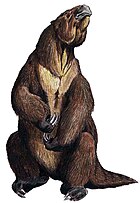Hapaloides
Appearance
| Hapaloides | |
|---|---|
| Scientific classification | |
| Domain: | Eukaryota |
| Kingdom: | Animalia |
| Phylum: | Chordata |
| Class: | Mammalia |
| Order: | Pilosa |
| Family: | †Megalonychidae |
| Subfamily: | †Ortotheriinae |
| Genus: | †Hapaloides Ameghino, 1902 |
| Type species | |
| †Hapaloides ignavus Ameghino, 1902
| |
| Other species | |
| |
Hapaloides is an extinct genus of ground sloth of the family Megalonychidae, endemic to Argentina during the Early Miocene. It lived from 21.0 mya to 17.5 mya, existing (as a genus) for approximately 3.5 million years.[1]
Found in the Colhuehuapian-aged Colpodon Beds of Argentina, three species are known: H. ignavus (the type species), H. laevisculus and H. ponderosus, all named by Florentino Ameghino in 1902.[2] H. ignavus is known from a partial cranium that is smaller than that of Hapalops rectangularis, which it was compared to.[2]
Ameghino in 1902 placed Hapaloides in the Megatheriidae,[2] alongside Proschismotherium, which was its sister taxon,[3][4] while more recent taxonomic reviews place Hapaloides within Megalonychidae.[1][5]
References
[edit]- ^ a b R. L. Carroll. (1988). Vertebrate Paleontology and Evolution 1–698
- ^ a b c Ameghino, Florentino (1902). "Première contribution a la connaissance de la faune mammalogique des couches a Colpodon [First contribution to the knowledge of the mammalian fauna of the Colpodon Beds]". Boletin de la Academia Nacional de Ciencias en Córdoba, República Argentina. 17: 71–141 [131–133].
- ^ "Hapaloides". Fossilworks. Archived from the original on 17 August 2022. Retrieved 11 August 2022.
- ^ "Proschismotherium". Fossilworks. Archived from the original on 26 September 2021. Retrieved 11 August 2022.
- ^ McKenna & Bell (1997) Classification of Mammals Above the Species Level

